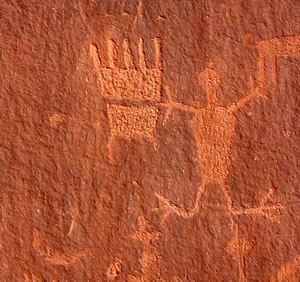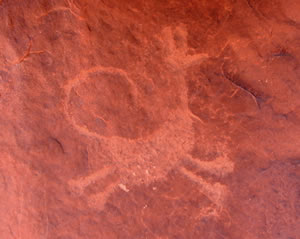Any
interpreter of ancient Indian rock art is probably a fool,
a charlatan, or an emotional masochist actively courting
opportunities to grovel in abject embarrassment while pleading
for crumbs of grudging forgiveness from other ruthless practitioners
of the affliction. This month’s article concerns some
of my interpretive theories regarding Moab area rock art.
 |
| This glyph on Potash Road
is a typical track found on many Moab area rock art
panels. |
Basketmaker
Indians moved into the Moab around 0 A.D. and stayed
for eight hundred years, more or less. They produced
many of the local petroglyphs, or rock art pictures,
that are pecked, scratched, and pounded into the desert’s walls and boulders. Basketmaker
Indians grew some crops, but they also did a lot of hunting
and gathering. Anthropologists talk about several rites
that seem fairly consistent among hunting cultures and
it seems reasonable to speculate that Moab’s Basketmaker
Indians had similar metaphysical protocols. One common
ceremony taps into the power of the most successful hunters
in the natural world. Another demonstrates an attitude
of respect toward the prey. I believe that these two magical
sentiments are common in Moab’s Basketmaker rock
art.
In the first case, the Basketmaker Indians made pictures
of mountain lions and lion tracks to access hunting power.
Mountain lion petroglyphs frequently sport short ears and
long tails. They are unusual but not uncommon. Lion-track
glyphs are prolific in the Moab area. According to one
so-called authority (me), Moab’s Basketmaker Indians
had a fairly local and highly stylized icon they used to
show a cat track. This glyph typically consists of a solid
heel, fork-like toes, and distinct claw marks. In other
parts of the Southwest similar glyphs are often interpreted
as bear or badger tracks. This may well be, but I think
that the preponderance of the Moab icons are meant to represent
cats. Rock art panels that show bighorn sheep in a stance
that signifies flight, surprise, or panic often include
a cat track. These are postures a sheep would assume if
it were in imminent danger of being munched.
 |
| The short ears and a long
tail of this glyph next to the golf course suggest
a mountain lion. |
The second
metaphysical metaphor, a respect toward the prey, is
indicated in the Moab area (according to the previously
cited ‘authority’)
by a Spirit Sheep. The Spirit Sheep sometimes has three
or four horns and a noble stance, often facing away from
most of the other sheep on a panel. Hunters around the
world implored the guardian spirit of their prey to be
generous to them, to show pity on their families, and give
them the gift of one of the flock. Frequently, the sacrificed
animal would be young or incapacitated. On panels that
include a Spirit Sheep I often see a small sheep in a serious
panic, sometimes with a spear or arrow in its body. Why
sheep? Because, here in the desert Southwest the hardest
thing to get into your diet is oil and sheep are greasy.
Before desert bighorns were decimated by European diseases
in the 19th century, there may have been as many as two
million on the Colorado Plateau. There are about forty
thousand today.
A well-known interpreter of rock art (not me) argues
that panels showing a hunter sticking a projectile
into a sheep represent shamans who have traveled to
the spirit world, impaling a critter that is actually
a rain deity. Thus, the panels are not about food,
but water. This interpretation might be true sometimes,
but in most cases I think it contradicts the well-accepted
scientific principal of parsimony expressed by the
axiom of Occam’s Razor and is, by that standard, largely a bunch of hogwash.
(I told you that rock art interpreters are contentious and abusive.)
I have many other foibles and follies I wish I had the space to discuss,
but I don’t. As for my theories, here are three places you can
go for a look-see.
P.S. Keep an eye on kids and teenagers near rock art panels. At that
age there’s a powerful “monkey see, monkey do” attraction
for the innocently ignorant (as opposed to the willfully ignorant) to
make a mark of their own in this big-old world.
Eddie
McStiff’s
I always try to include one easy trip in my column. This month I suggest
the bar at Eddie McStiff’s. A few years ago Eddie saw some drawings
I made to illustrate the principals discussed in this article and asked
if I’d like to do some paintings in his restaurant. You bet.
The three paintings, while not entirely accurate, are true to the spirit
of the originals. As you enter the bar, the first illustration represents
the “Indian Writings” panel on Potash Road, the second
a panel is in Hidden Valley, and the third panel is at an undisclosed
location. Besides cats, cat tracks, and Spirit Sheep these pictures
include two other symbols I consider diagnostic for hunting magic.
Whenever I see hatch-marks or fence-like figures I consider the possibility
of nets and traps. Basketmaker Indians got most of their protein by
trapping and netting, not impalement. (When I’m at Eddie’s
I get most of my sustenance from the Chestnut Brown and Cobb Salad.)
The other symbol is a long-legged, long-necked, long-beaked bird that
I think is a heron. Like the lion, the heron is a ferocious hunter.
While heron glyphs are nowhere near as common as lion-sign, they aren’t
uncommon either. There are many heron around Moab living along the
river, streams, and wetlands.
Hidden Valley
Hidden Valley is one of the most intense rock art sites in the region.
Drive south on Hwy 191, 3½ miles from Center and Main to Angel
Rock Road and follow the BLM signs to the trailhead. The trail to the
glyphs is about 2 ½ miles long with a 600 foot rise. When you
get to the pass, go up to the wall on your right. The south-facing
walls of this horseshoe-shaped formation are packed with petroglyphs,
many of them about hunting and fighting. I believe that this area was
particularly important to Basketmaker men and that, two thousand years
ago, the beautiful valleys you just walked through may have been a
prime locale for ritual tribal warfare with duck-headed infidels from
Blanding and Bluff. But that’s another story.
Johnson’s
Up-On-Top
This is a tougher hike, and while not very long, takes a little bit of
panache and some route-finding skills. Take Spanish Valley Drive 3
miles south from where it meets Golf Course Road. You’ll see
a dirt road with a pump house at the intersection. Go up that road
and straight across the top of the mesa known as Johnson’s Up-On-Top.
High clearance is preferable, but not necessary. There is a hanging
valley above Mill Creek Canyon and a free-standing formation of Navajo
Sandstone on the rim, a few hundred yards down and to the right. A
sketchy trail into the bottom of the canyon starts at the south end
of the formation. This canyon is loaded with rock art, including some
fascinating examples of what I have been discussing.
Rory Tyler leads
custom rock art tours and backcountry hikes for people
of all skill levels for Canyon Voyages Adventure Company.
Cryptos (krip’ tose):
The surface of Moab’s desert is held together
by a thin skin of living organisms known as cryptobiotic
soil or cryptos. It has a lumpy black appearance,
is very fragile, and takes decades to heal when
it has been damaged. This soil is a critical
part of the survival of the desert. The cryptobiotic
organisms help to stabilize the soil, hold moisture,
and provide protection for germination of the
seeds of other plants.
Without
it the dry areas of the west would be much
different. Although some disturbance is normal
and helps the soil to capture moisture, excessive
disturbance by hooves, bicycle tires and hiking
boots has been shown to destroy the cryptobiotic
organisms and their contribution to the soil.
When you walk around Moab avoid crushing the
cryptos. Stay on trails, walk in washes, hop
from stone to stone.
Whatever
it takes, don’t crunch the cryptos unless
you absolutely have to! |
|

